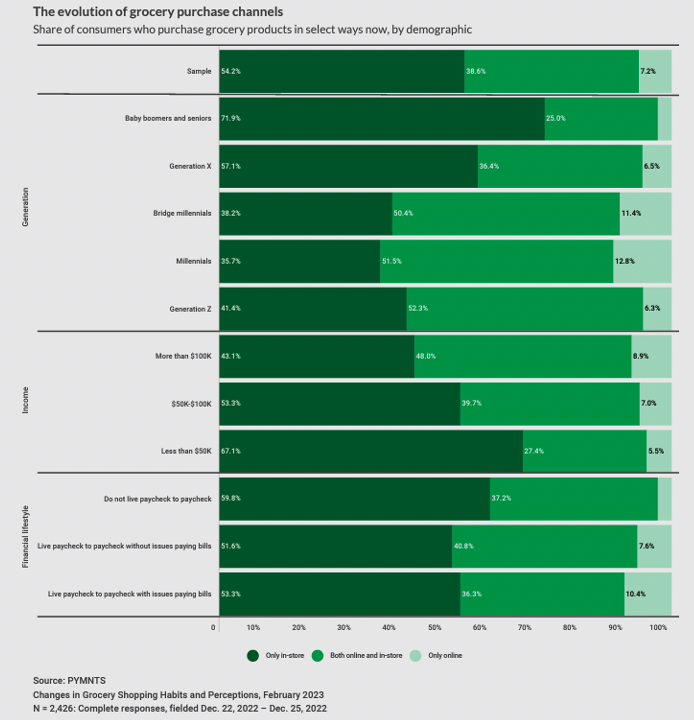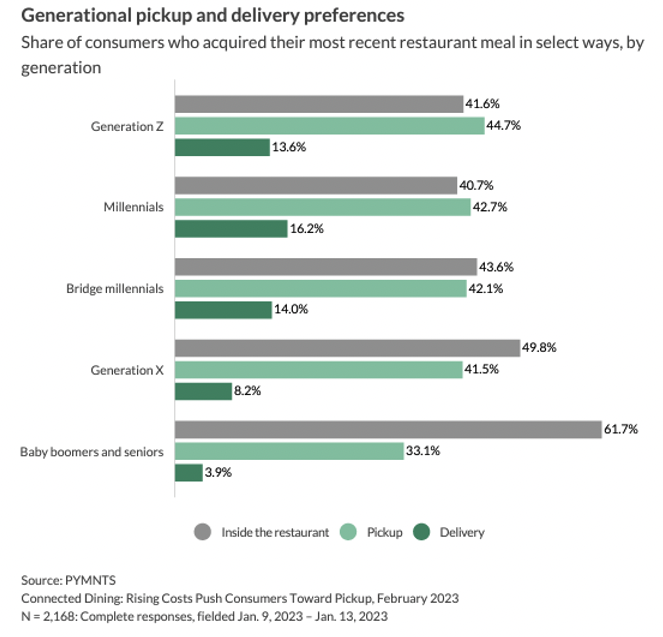Delivery Versus Pickup Preference Comes Down to Money
Consumers face the choice between the effort to pick up and paying for bring-it-to-me convenience when buying goods.
PYMNTS researched three categories — retail, restaurant meals and groceries — and found that across demographics, consumers prefer convenience, so long as it is within their budgets.
Groceries
PYMNTS’ study “Changes in Grocery Shopping Habits and Perceptions” revealed that only 46% of shoppers use a mix of in-store and online platforms or opt for digital-only grocery shopping.

Baby boomers and seniors outpace other age demographics in preferring to shop at brick-and-mortar locations. Among income brackets, consumers earning less than $50,000 per year shop in stores the most. However, when it comes to consumers with different financial lifestyles, consumers who do not live paycheck to paycheck shop exclusively in stores the most. One motivation for these consumers to shop in stores could be convenience. These consumers may seek deals less than paycheck-to-paycheck consumers do. These consumers could prefer picking up their goods using the standard checkout and bagging procedures.
When it comes to online grocery purchases, however, the numbers may not tell the full story. As more traditional grocers integrate some level of eCommerce into their sales strategy, U.S. consumers are using cross-channel options to take advantage of features such as buy online, pick up in store (BOPIS) and curbside pickup. While consumers across demographics have embraced the convenience of these options, some are more likely than others to favor BOPIS or curbside pickup. Forty-five percent of men and 36% of women who buy groceries online opt for curbside pickup, and 43% of men and 30% of women opt for BOPIS. PYMNTS’ research on age demographics reveals that zillennials, the generation bridging younger millennials and older Generation Zers, prefer picking up their groceries in stores, with 86% opting to do so.
Recognizing consumers’ interest in pickup, eGrocery platforms are opening curbside-only grocery stores as they seek to become competitive players in the sector.
Retail
By the end of 2022, an average of 131 million consumers across the country had online retail purchases delivered every month, according to PYMNTS’ “12 Months of the ConnectedEconomy™” report. Over half of consumers ordering on a retail merchant’s site opted for home delivery.
The share of U.S. eCommerce shoppers opting for BOPIS and curbside for their most recent purchase rose from 23% in 2021 to 32% in 2022. A prime factor driving pickup’s popularity may be increased shipping costs, as merchants have begun either rolling back free shipping or raising the minimum spend needed to qualify. Consumers seeking to cut discretionary costs could skip the delivery charge at the cost of convenience by choosing BOPIS or curbside pickup.
In-store shopping remains a popular option, however, with 92% of zillennials and 90% of millennials opting to do so.
Restaurant Meals
PYMNTS’ “Connected Dining: Rising Costs Push Consumers Toward Pickup” report revealed that pickup beats delivery as consumers’ preferred mode of receiving restaurant meals eaten off-premises.

Baby boomers and seniors were the least likely of any generation to opt for delivery for their last restaurant meal. However, that may soon change. PYMNTS research found 14% of boomers and seniors have used a third-party aggregator over the past six months, with nearly half doing so due to improved offers and discounts. Use of third-party aggregators has surged with Generation Z as well, as 69% of this age cohort reported using an aggregator in the last six months.
The Connected Dining report also found that 12% of consumers earning above $100,000 annually had their most recent restaurant meal delivered, the highest share among income brackets. Higher-income earners also increased their use of third-party aggregators, with the share increasing from 42% to 49% in the past six months. One explanation for higher-income consumers both opting for delivery and using aggregators more than other income brackets may be that they have more discretionary funds available to pay for convenience surcharges.
Pickup versus bring-to-me preferences broadly come down to convenience and affordability. Consumers across generations, income brackets and financial lifestyles are generally seeking strategies to cut costs. This behavior most clearly plays out in the overwhelming preference toward picking up restaurant meals — unless delivery may be afforded. However, shoppers have embraced curbside pickup and BOPIS, suggesting consumers overall still seek convenience if it does not impact their budgets.
For all PYMNTS retail coverage, subscribe to the daily Retail Newsletter.

